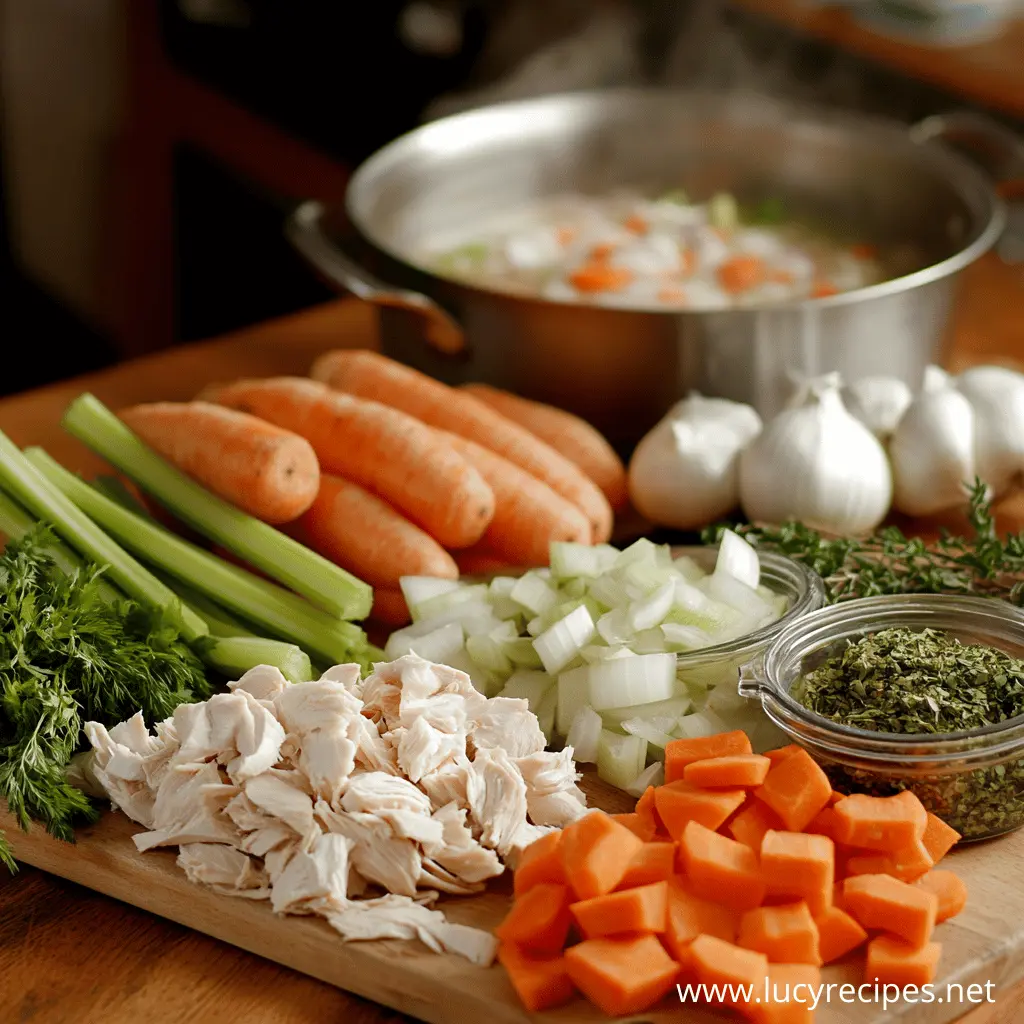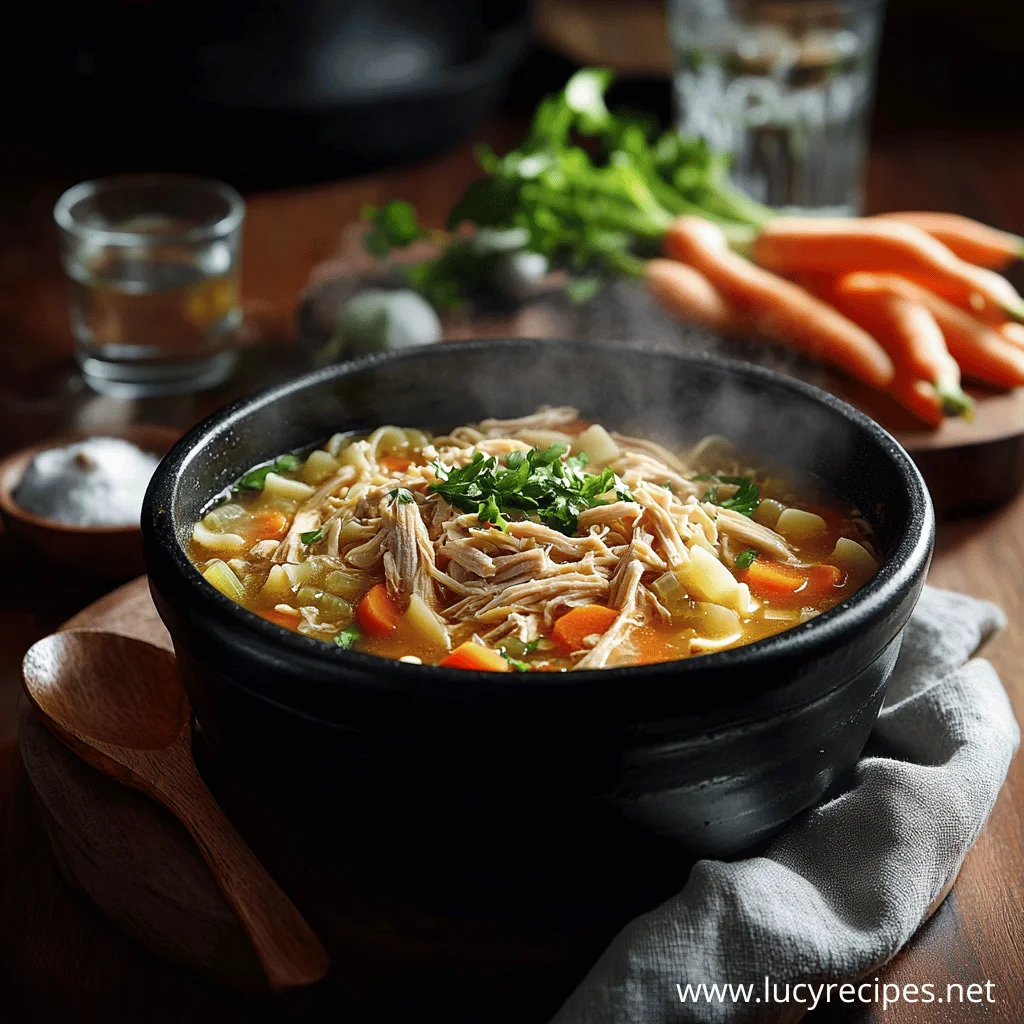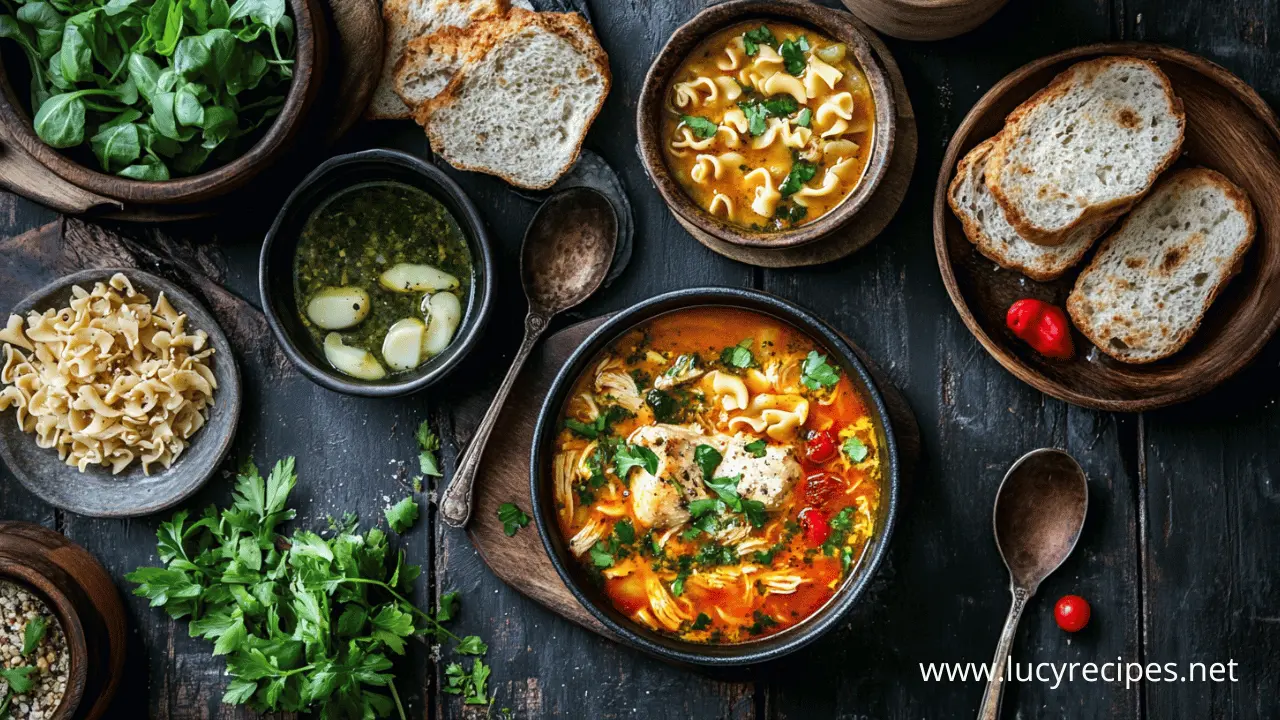Introduction
There’s nothing quite like a bowl of chicken noodle soup to soothe the soul and warm the heart. Whether it’s a chilly day, you’re feeling under the weather, or you just need a comforting classic, this timeless dish never fails to deliver. With its rich, savory broth, tender chicken, and perfectly cooked noodles, chicken noodle soup is the ultimate feel-good meal.
What makes this soup so special is its versatility. From quick weeknight dinners to slow-simmered Sunday meals, it can be as simple or as hearty as you like. Plus, it’s easy to customize—whether you prefer to pack it with fresh vegetables, add a hint of spice, or use your favorite kind of noodles.
Ready to dive into a bowl of this comforting classic? Stick around for tips, techniques, and a recipe that’ll make your kitchen smell like home. Let’s bring some warmth to your table!
Table of Contents
The Importance of Quality Ingredients in Chicken Noodle Soup
When it comes to making chicken noodle soup, the quality of your ingredients can make all the difference. This classic dish relies on simple components, so each one needs to shine. Using fresh, high-quality ingredients transforms a basic soup into something truly comforting and flavorful.
Start with the chicken. Opt for bone-in pieces, like thighs or a whole chicken, for a broth that’s rich and full-bodied. The natural collagen from the bones gives the soup its signature silky texture. If you’re short on time, rotisserie chicken works well too, adding convenience without sacrificing taste.
Next, choose fresh vegetables. Crisp carrots, celery, and onions are the base of your soup, offering sweetness and balance. When it comes to the noodles, egg noodles are a classic choice, but selecting a high-quality variety ensures they hold up beautifully in the broth.
By prioritizing quality ingredients, you’ll create a chicken noodle soup that’s not just delicious but truly nourishing—perfect for any occasion!
Broth Basics: The Heart of Chicken Noodle Soup
The broth is the soul of any chicken noodle soup, setting the stage for every other ingredient to shine. A well-made broth transforms the dish from ordinary to extraordinary, delivering rich, comforting flavors in every spoonful. You can take inspiration from how to enhance ziti dishes by incorporating fresh herbs and spices for depth.
For the best results, consider making your broth from scratch. Start with chicken bones or a whole chicken to create a base that’s packed with natural flavor and nutrients. Simmer them slowly with aromatic vegetables like onions, carrots, and celery, and don’t forget the bay leaves, garlic, and peppercorns for depth. Skimming the surface as it cooks ensures a clear, clean broth.
If you’re short on time, high-quality store-bought broth works too—just look for low-sodium options so you can control the seasoning. Enhance it by simmering with fresh herbs or leftover chicken bones for a homemade touch.
A well-crafted broth is more than just liquid; it’s the comforting foundation that brings chicken noodle soup to life. Take the time to perfect it, and your soup will truly shine.
Choosing the Perfect Chicken for Chicken Noodle Soup

The chicken you choose for your chicken noodle soup plays a starring role in both flavor and texture. Selecting the right type can elevate your soup from good to absolutely unforgettable.
For the richest, most flavorful broth, start with bone-in chicken. A whole chicken or parts like thighs and drumsticks are ideal, as the bones and connective tissue release collagen and nutrients during simmering. This creates a broth that’s silky, savory, and deeply nourishing. Skin-on pieces also add extra flavor, which can be skimmed off for a lighter option.
If you’re in a hurry, rotisserie chicken is a convenient alternative. While it won’t offer the same depth of flavor for the broth, its tender meat shreds beautifully and saves prep time.
For a leaner option, opt for boneless, skinless breasts, but pair them with pre-made or enhanced broth to maintain richness.
No matter your choice, the right chicken makes your chicken noodle soup hearty, flavorful, and utterly satisfying. Choose wisely, and your soup will steal the show!
Vegetables That Elevate Your Chicken Noodle Soup
While chicken and noodles may take center stage, the vegetables in your chicken noodle soup are the unsung heroes, adding layers of flavor, texture, and nutrients. Choosing the right mix of veggies can transform your soup from simple to sensational.
The classic trio of onions, carrots, and celery—often called mirepoix—forms the foundation of the soup’s savory flavor. These vegetables are gently sautéed to release their natural sweetness, creating a balanced base.
To elevate your soup further, consider adding garlic for a hint of warmth, parsnips for a touch of sweetness, or leeks for a mild, oniony depth. Fresh herbs like parsley, thyme, and dill add brightness, while spinach or kale can give the soup a healthy, vibrant twist.
For a hearty, rustic feel, toss in diced potatoes or sweet corn. These additions not only bulk up the soup but also bring exciting textures to each bite.
With the right vegetables, your chicken noodle soup becomes a colorful, flavorful masterpiece—perfect for cozy dinners or special family gatherings. Experiment and make it your own!
The Role of Herbs and Spices in Chicken Noodle Soup
Herbs and spices are the magic ingredients that turn a simple chicken noodle soup into a flavorful and aromatic masterpiece. They enhance the natural flavors of the chicken and vegetables while adding depth and character to every spoonful.
Fresh herbs like parsley, thyme, and dill are classic choices. Thyme lends an earthy, savory note, while parsley adds a fresh, clean flavor. A sprinkle of dill offers a delicate, slightly tangy finish that pairs beautifully with the broth.
For dried spices, a touch of bay leaf and black pepper is essential. Bay leaves infuse the soup with a subtle, herbaceous aroma, while freshly ground black pepper adds a hint of spice. If you want to spice things up, try a pinch of paprika or a dash of cayenne for warmth.
For a unique twist, consider adding ginger or turmeric for an anti-inflammatory boost and a pop of flavor.
Carefully chosen herbs and spices make your chicken noodle soup irresistible. Experiment with combinations to suit your taste and turn every bowl into a comforting, fragrant delight.
The Noodles Debate: Choosing the Best for Chicken Noodle Soup
When it comes to chicken noodle soup, the choice of noodles is a surprisingly big deal. The type of noodle you use can completely change the texture, flavor, and even the heartiness of your soup.
Classic egg noodles are a favorite for their wide, ribbon-like shape and tender, slightly chewy texture. They hold up well in the broth without turning mushy, making them a go-to for traditional recipes. For those looking for a lighter option, thin noodles like angel hair or vermicelli can give your soup a delicate, silky feel.
If you’re craving something more filling, try hearty options like rotini or farfalle. These shapes trap bits of chicken and vegetables, ensuring every bite is packed with flavor. For a unique twist, consider rice noodles or udon for a fusion-inspired take.
Whichever noodle you choose, be sure to cook them just until al dente. Overcooking can leave you with a mushy mess instead of the perfect bowl of chicken noodle soup. So, pick your favorite and get ready to slurp up some deliciousness!
Special Techniques for Depth of Flavor in Chicken Noodle Soup

Creating a truly memorable chicken noodle soup isn’t just about the ingredients—it’s about the techniques that bring them to life. A few simple steps can dramatically deepen the flavor and elevate your soup to restaurant-quality.
- Roast the Chicken and Vegetables
Roasting chicken bones or whole pieces before simmering adds a rich, caramelized flavor to the broth. Tossing the carrots, onions, and celery in a bit of olive oil and roasting them alongside the chicken intensifies their sweetness. - Simmer Low and Slow
Patience is key. Cooking the soup on low heat for several hours allows the flavors to meld and the collagen in the chicken bones to break down, creating a luscious, velvety broth. - Deglaze the Pot
After sautéing your vegetables, deglaze the pot with a splash of white wine, sherry, or even apple cider vinegar. This step lifts all those delicious browned bits stuck to the bottom, infusing the broth with extra depth. - Add Layers of Herbs and Spices
Instead of throwing all the herbs in at once, add them at different stages. Simmer hearty herbs like thyme and bay leaves early on, and stir in delicate herbs like parsley or dill right before serving for a burst of freshness. - Finish with Acid
A squeeze of fresh lemon juice or a splash of vinegar brightens the flavors and balances the richness of the soup, making every bite sing.
By mastering these techniques, your chicken noodle soup will have a depth and complexity that’s guaranteed to impress. A little extra effort goes a long way toward creating a bowl that’s truly unforgettable!
Dietary Adaptations for Chicken Noodle Soup
One of the great things about chicken noodle soup is how adaptable it is to different dietary needs. With a few thoughtful substitutions, you can tailor this classic comfort food to suit almost any preference or restriction without sacrificing flavor.
Gluten-Free Options
Swap out traditional egg noodles for gluten-free alternatives like rice noodles, chickpea pasta, or spiralized zucchini. Many stores now carry gluten-free egg noodles for a classic feel.
Low-Carb or Keto-Friendly
For a low-carb version, replace noodles with spiralized vegetables like zucchini or yellow squash. Shirataki noodles are another great alternative for those following a keto plan.
Dairy-Free
Good news: most chicken noodle soups are naturally dairy-free! Just double-check store-bought broths to ensure they don’t contain any hidden dairy products.
Vegetarian or Vegan
Replace chicken with hearty ingredients like tofu, jackfruit, or chickpeas. Use vegetable broth instead of chicken broth, and add extra herbs and spices for depth.
Low-Sodium
Make your own broth to control the salt content. Season with fresh herbs, garlic, and a splash of lemon juice for flavor without relying on sodium.
Paleo and Whole30
Omit the noodles and load up on vegetables like sweet potatoes, parsnips, and spinach for a satisfying, grain-free twist. Use homemade broth and pasture-raised chicken to keep it Whole30-compliant.
With these dietary adaptations, you can enjoy the comforting warmth of chicken noodle soup while meeting your health goals or catering to dietary restrictions. It’s a bowl of comfort for everyone!
Common Mistakes and How to Avoid Them in Chicken Noodle Soup
Even though chicken noodle soup is a simple, comforting dish, a few common missteps can keep it from reaching its full potential. Here are some pitfalls to avoid and tips to ensure your soup turns out perfect every time.
1. Overcooking the Noodles
Adding noodles too early can leave them mushy and overly soft. To avoid this, cook noodles separately and add them to the soup just before serving, or undercook them slightly in the broth so they finish perfectly.
2. Using Bland Broth
The broth is the backbone of the soup. Using low-quality or unseasoned broth can make the soup taste flat. Opt for homemade broth or enhance store-bought options by simmering them with aromatics like garlic, herbs, and chicken bones.
3. Skipping the Skim
Not skimming the fat and foam from the broth during simmering can lead to a greasy texture. Take a few minutes to skim the surface periodically for a cleaner, lighter soup.
4. Overloading the Pot
Adding too many ingredients can overwhelm the broth, leaving it more stew-like than soup. Stick to the essentials and maintain a good broth-to-solid ratio.
5. Underseasoning
Salt is crucial for bringing out the flavors in the soup. Taste frequently and adjust seasoning as needed, especially toward the end of cooking.
6. Rushing the Cooking Process
Good soup takes time. Simmering the broth slowly allows the flavors to develop and meld. Avoid boiling, as it can make the chicken tough and cloudy the broth.
7. Forgetting the Fresh Touch
A final sprinkle of fresh herbs or a squeeze of lemon juice brightens the flavors and gives the soup a fresh, vibrant finish. Don’t skip this step!
By sidestepping these common mistakes, your chicken noodle soup will turn out consistently delicious—perfect for cozy nights, sick days, or simply when you’re craving a bowl of comfort.
Serving Suggestions for Chicken Noodle Soup
A warm bowl of chicken noodle soup is a comforting meal on its own, but pairing it with the right sides and garnishes can elevate the experience. Here are some serving suggestions to make your soup shine.
1. Bread Pairings
- Crusty Bread: A slice of fresh, crusty sourdough or a baguette is perfect for dipping into the flavorful broth.
- Garlic Bread: Add a bit of indulgence with buttery, garlicky toast alongside your soup.
- Dinner Rolls: Soft, warm rolls are ideal for soaking up every last drop of broth.
2. Fresh Salads
- Pair your soup with a simple green salad dressed in a light vinaigrette. The crispness of the veggies provides a refreshing contrast to the hearty soup.
- For something heartier, try a Caesar salad or a spinach and strawberry mix.
3. Toppings for Extra Flavor
- Sprinkle fresh herbs like parsley, dill, or chives on top for a burst of brightness.
- A squeeze of fresh lemon juice enhances the broth’s depth and balances its richness.
- Crushed crackers, croutons, or crispy fried onions can add a delightful crunch.
4. Cheese Pairings
- Shaved Parmesan or a sprinkle of cheddar adds a creamy, savory kick.
- Serve with a side of cheese sticks for a kid-friendly pairing.
5. Beverages
- For a classic combo, serve the soup with iced tea or lemonade.
- Feeling cozy? Pair it with a warm drink like herbal tea or a hot toddy for extra comfort.
These thoughtful pairings and garnishes ensure your chicken noodle soup feels like a complete meal, ready to impress at the dinner table or soothe your soul on a quiet evening.
Storing and Reheating Tips for Chicken Noodle Soup
Properly storing and reheating chicken noodle soup ensures you can enjoy this comforting dish as leftovers without compromising flavor or texture. Here’s how to keep your soup fresh and delicious:
Storing Tips
- Separate the Noodles
If you plan to store leftovers, remove the noodles from the soup before refrigerating. This prevents them from soaking up too much broth and becoming mushy. - Cool Before Storing
Allow the soup to cool to room temperature before transferring it to airtight containers. This helps prevent condensation, which can dilute the broth. - Use the Right Container
Store soup in glass or BPA-free plastic containers with secure lids to preserve freshness. Divide into portion-sized containers for easy reheating. - Refrigeration and Freezing
- Refrigerate soup for up to 4 days.
- For longer storage, freeze it (without the noodles) in freezer-safe containers for up to 3 months.
Reheating Tips
- Thaw Safely
If frozen, thaw the soup overnight in the refrigerator or use the defrost setting on your microwave. - Stovetop Reheating
Reheat the soup on medium heat, stirring occasionally, until it reaches a simmer. Avoid boiling, which can overcook the chicken and vegetables. - Microwave Reheating
Heat in a microwave-safe bowl, covering it loosely to prevent splatters. Stir every minute to ensure even heating. - Add Fresh Noodles
For the best texture, cook a fresh batch of noodles and add them to the reheated soup just before serving.
By following these tips, your chicken noodle soup will taste just as comforting and delicious the next day—or even weeks later!
Nutritional Benefits of Chicken Noodle Soup

Chicken noodle soup isn’t just comforting; it’s packed with nutritional benefits that make it a wholesome choice for meals, especially when you need a little extra nourishment. Here’s why this classic dish is as good for your body as it is for your soul:
1. Immune Support
The warm broth is hydrating and helps soothe sore throats, while ingredients like garlic, onions, and carrots are rich in antioxidants, which may support immune function.
2. High-Quality Protein
Chicken is an excellent source of lean protein, essential for muscle repair and immune health. It also contains important nutrients like B vitamins, which help boost energy levels.
3. Hydration and Electrolytes
The salty broth replenishes electrolytes, making it particularly beneficial when you’re feeling under the weather or dehydrated. Additions like celery provide natural sodium and potassium.
4. Rich in Vitamins and Minerals
The vegetables in chicken noodle soup, such as carrots, celery, and onions, are loaded with vitamins A, C, and K, as well as minerals like potassium and magnesium. These nutrients support heart health, bone strength, and overall well-being.
5. Digestive Comfort
The warm, easy-to-digest nature of chicken noodle soup makes it gentle on the stomach, perfect for those recovering from illness or seeking a light meal.
6. Low in Calories (with Smart Choices)
When made with lean chicken and low-sodium broth, chicken noodle soup is a satisfying, low-calorie meal that fits into many healthy eating plans.
By combining these nutritional benefits with its delicious flavor, chicken noodle soup is a comforting dish that nourishes both body and mind—perfect for a balanced diet or whenever you need a little pick-me-up!
FAQs
1. Can I make chicken noodle soup ahead of time?
Absolutely! Chicken noodle soup is great for meal prep. To avoid mushy noodles, store them separately and add them when reheating the soup.
2. What type of noodles work best in chicken noodle soup?
Egg noodles are a classic choice because they hold up well in broth, but you can use any noodle you prefer, like rotini, vermicelli, or even gluten-free options.
3. How long does chicken noodle soup last in the fridge?
When stored in an airtight container, chicken noodle soup can last up to 4 days in the refrigerator. For best results, keep the noodles separate.
4. Can I freeze chicken noodle soup?
Yes! Chicken noodle soup freezes well, but it’s best to freeze it without the noodles to prevent them from becoming mushy. Add freshly cooked noodles when reheating.
5. How can I thicken my chicken noodle soup?
For a thicker soup, you can:
- Add a slurry of cornstarch and water.
- Mash some of the vegetables in the soup for natural thickening.
- Stir in a small amount of cream or a roux for a richer texture.
6. Can I make chicken noodle soup vegetarian?
Yes! Substitute the chicken with chickpeas, tofu, or jackfruit and use vegetable broth instead of chicken broth. Add extra herbs and spices for a flavorful vegetarian version.
7. Why is my chicken noodle soup cloudy?
Cloudy broth often results from boiling the soup instead of simmering it. To keep it clear, cook on low heat and skim the surface periodically.
8. What are some good add-ins for chicken noodle soup?
Consider adding:
- Spinach or kale for extra greens.
- A squeeze of lemon juice for brightness.
- Spices like turmeric or paprika for a twist in flavor.
With these answers, making and enjoying chicken noodle soup is easier than ever, whether you’re a seasoned cook or trying it for the first time!
Conclusion: The Timeless Comfort of Chicken Noodle Soup
Chicken noodle soup is more than just a recipe—it’s a bowl of comfort, a cure-all for the soul, and a dish that brings people together. Whether you’re craving a cozy meal on a chilly day, seeking nourishment while feeling under the weather, or simply indulging in a timeless classic, this soup has a special way of delivering satisfaction.
From its rich, flavorful broth to tender chicken, hearty noodles, and fresh vegetables, every element works in harmony to create a dish that’s both simple and deeply rewarding. With endless options for customization, it’s a recipe you can make uniquely your own, catering to your tastes and dietary needs.
So, roll up your sleeves and get cooking! Whether you’re perfecting a family recipe or trying it for the first time, chicken noodle soup is always a good idea. Warm, nourishing, and timeless—it’s a meal that feels like a hug in every spoonful.

